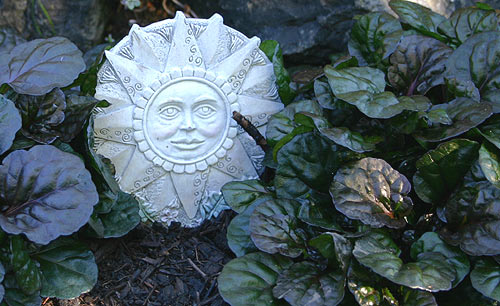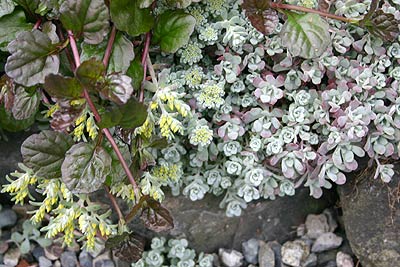Ajuga reptans 'Black Scallop'
BUGLEWEED
Family: Lamiaceae
Pronounced: a-JOO-ga REP-tanz
Quick Jumps
Growing Guide
Rainy Side Notes
GROWING GUIDE

Geographical origin:
Garden.
Plant group:
Perennial.
Hardiness:
Sunset zones: A2, A3; 1-24.
USDA zones: 3-9.
Heat zones: 9-1.
Mature size:
Height: 3-6 inches (7-15 cm).
Width: 36 inches (90 cm) or more.
Flowering period:
Late spring, early summer.
Flowering attributes:
Deep blue flowers on spikes.
Leaf attributes:
Dark burgundy, scalloped foliage, so dark they appear black.
Growth habit:
Spreading evergreen (in the Pacific Northwest) ground cover.
Light:
Partial shade to sun.
Soil:
Moist soil; will tolerate poor soils.
Feeding:
Apply compost or manures thinly over the soil after pruning the plants.
Propagation methods:
Division of rooted stems. Note: Because the plant is patented, a license is required for propagation.
Pruning methods:
When necessary cut foliage back to the ground after flowering to rejuvenate the foliage. Mow large areas of bugleweed with a lawn mower; however, in small patches of Ajuga, trim plants back with pruning shears or weed trimmer. Where not wanted, trim back the runners before they take root. Approximately every third year, thin out plants to reduce the chance of crown rot.
Rainy Side Notes

Ajuga reptans ‘Black Scallop’ is a patented plant, discovered by Mike Tristram of the UK as a mutation on tissue cultured plants. With beautiful dark, glossy foliage, ‘Black Scallop’ is so dark it appears almost black; this plant would be a great addition to a black-themed garden. ‘Black Scallop’ is an excellent choice for containers and exceptional with light or silver foliage plants. In addition, its spikes of blue flowers stand out against the dark foliage. I have Sedum spathulifolium var. purpureum and our native Sedum spathulifolium 'Cape Blanco' spilling down over the edges of a rock wall in front of the deep dark leaves of Ajuga ‘Black Scallop’. It is a striking combination; however, in spring I have to keep the runners of the ajuga from taking over the sedum.
As with many ajugas, this plant spreads by above ground runners. After it flowers in spring, it sends out runners in all directions (right photo), making that the best time to cut them back, making sure the plant stays in bounds. If the runners are rooted, they are easily dug up before they are too well established. The rest of the year, the plants sit quietly until the following year’s spring fling.
Plant in full sun or partial shade; the more sun this cultivar receives, the darker the foliage will be. For a quick weed-suppressing ground cover, space plants 10 to14 inches apart when planting .
Photographed in author's garden.

Gardening for the Homebrewer: Grow and Process Plants for Making Beer, Wine, Gruit, Cider, Perry, and More
By co-authors Debbie Teashon (Rainy Side Gardeners) and Wendy Tweton
Copyright Notice | Home | Search | Perennials

